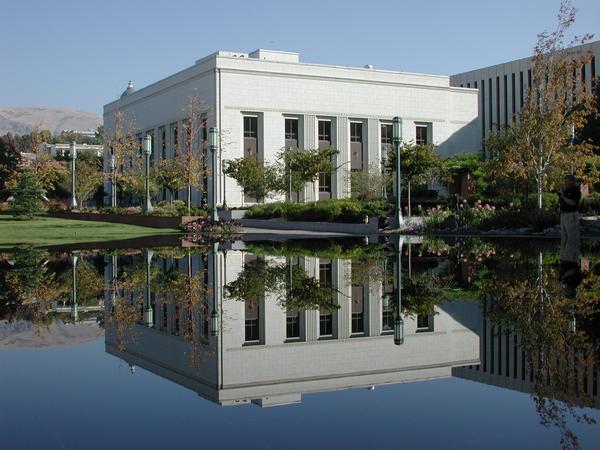
When the Relief Society was reorganized in Salt Lake City, women needed a place to meet. Since there were, at first, so few of them, it was easy to gather together in each other’s homes. As the Society grew though, it was clear larger quarters would be necessary.
Chapels, at that time, did not have room for the Relief Societies to meet, so women began the task of building their own halls. Later, chapels would be built with a room attached, especially for the Relief Society to use. The money for these Relief Society halls came from wheat sales, bazaars, and Co-operative stores. Originally, these halls were designed after Joseph Smith’s Red Brick Store, in Nauvoo. Co-operative stores, where women would make items to sell, took up the main level while the upstairs level was used for meetings and workrooms.
As sisters gathered together in their various parts of the world, however, there became a need to centralize the General Relief Society Presidency, where they could greet visitors, run their magazine-the Relief Society Magazine, and meet and coordinate as officers. The first such office was in Emmeline B. Wells home, where she edited The Woman’s Exponent.
Back in 1896, they were already talking about having a special building just for the use of the women. Sarah M. Kimball, a counselor in the RS Presidency, said because women have
“contributed to all public places, now we want to have a house and we want the land to build it on and it should be in the shadow of the temple.”
Pres. Lorenzo Snow offered to give them the deed for land just east of the temple (the back end of the present Joseph Smith Memorial Building) if the sisters could come up with $20,000 for the building materials. The women immediately sent the word out to pitch in $5 for this wonderful project.
Three years later, the sisters had sent in $14,005 and were well on their way to getting their own building, until rumors circulated that the project was being shelved.
When RS President Bathsheba Smith first heard about it, she fainted. The plans had been changed so that a Presiding Bishop’s building would be built in that spot. The Presiding Bishopric offered to make one of the floors available to the three women’s auxiliary officers. The women were not happy, but they were gracious as they accepted the offer and set up offices on the second floor of the new Bishop’s building, which was dedicated in January of 1910.
It wasn’t until 1945 that the idea for a new building for the women began to develop. President George Albert Smith said, “I don’t care how fine it is, how large it is or how beautiful it is; it will not be better

than you deserve.” All sisters were encouraged to send in $5 as a contribution to the building of this edifice. Because this was just after the war, and $5 was a small fortune for these women, they used their creativity and resourcefulness to earn the money and send it in. Some women took in extra sewing, cleaning, ironing; they sold eggs, sold embroidered pillowcases, took on more music students.
The building was to be built across the street from the temple, “in its shadow,” but this time on the northwest corner of the block; the Bishop’s Building has since been torn down.
An eighty-year-old woman traveled from Southern Utah to deliver her $5 personally to Sis. Belle Spafford. She explained that she had contributed $5 to the original building that was never built, and she wanted to know what became of that money. Sis. Spafford told her that the Brethren were giving the original money earned back toward the new building. So, this woman, to her great satisfaction, had actually contributed $10 toward the cause. Everyone, who contributed money, has their name written in a record book. To this day, you can walk into the Relief Society Building and see this book on display. You might want to look up your mother’s name.
On October 3, 1956, the Relief Society Building was dedicated by President David O. McKay, with Sister Belle S. Spafford serving as president. The building is three stories high with a basement. It has large receiving rooms where sisters can gather for instruction. There are offices for all of the leaders of the women’s auxiliaries. The building originally also housed the offices of the Relief Society Magazine, the Welfare Department, and the Temple and Burial Clothing Department. The building itself is decorated with bronze sheaves of wheat; always in remembrance of the largest Relief Society project undertaken.
In the Dedicatory Prayer, Pres. McKay said,
“On this memorable occasion, we praise thy name for the organization of the Relief Society of The Church of Jesus Christ of Latter-day Saints, for the thousands of loyal, faithful, beautiful women who compose its membership. Their devotion to duty is never-ending; their loyalty to Thee and to Thy Priesthood unquestioned; their administrations to the sick and to the needy, untiring; their sympathetic, gentle services give hope to the dying, comfort and faith to the bereaved. O Father, bless these, thy choice, beloved handmaidens!”
On March 17, 2006, the building went through a major remodel and was rededicated by Pres. Gordon B. Hinckley, and Sister Bonnie D. Parkin as president. The building has served as a constant resource where ideas are displayed for all of the auxiliaries as well as Welfare, Sunday School, Home Storage, Priesthood, Military, LDS Student Association, etc.